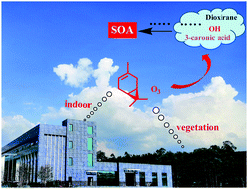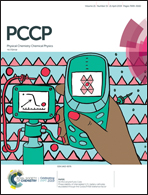Ozonolysis of 3-carene in the atmosphere. Formation mechanism of hydroxyl radical and secondary ozonides†
Abstract
The gas-phase ozonolysis mechanism of 3-carene is investigated using high level quantum chemistry and kinetic calculations. The reaction follows the Criegee mechanism with an initial addition of O3 to the ![[double bond splayed left]](https://www.rsc.org/images/entities/char_e009.gif) C
C![[double bond, length as m-dash]](https://www.rsc.org/images/entities/char_e001.gif) C
C![[double bond splayed right]](https://www.rsc.org/images/entities/char_e00a.gif) bond, followed by a chain of unimolecular isomerizations, as 3-carene + O3 → POZs (primary ozonides) → CIs (Criegee intermediates, 4 conformers) → Ps (products). In the course of the reaction, a large excess of energy retained in the POZs* lead to the prompt unimolecular processes in POZs*, CIs*, and Ps*, and only ∼4% of CIs* could be stabilized by collision at 298 K and 760 Torr. From RRKM-ME calculations, the VHPs* could further dissociate to vinoxy-type radical and OH radical, the SOZs* could isomerize to 3-caronic acid, and DIOs* could be stabilized via collision. The fractional yield of OH radical, in the range of 0.56 to 0.59, agrees reasonably well with the previously measured value of 1.06 (with an uncertainty factor of 1.5).
bond, followed by a chain of unimolecular isomerizations, as 3-carene + O3 → POZs (primary ozonides) → CIs (Criegee intermediates, 4 conformers) → Ps (products). In the course of the reaction, a large excess of energy retained in the POZs* lead to the prompt unimolecular processes in POZs*, CIs*, and Ps*, and only ∼4% of CIs* could be stabilized by collision at 298 K and 760 Torr. From RRKM-ME calculations, the VHPs* could further dissociate to vinoxy-type radical and OH radical, the SOZs* could isomerize to 3-caronic acid, and DIOs* could be stabilized via collision. The fractional yield of OH radical, in the range of 0.56 to 0.59, agrees reasonably well with the previously measured value of 1.06 (with an uncertainty factor of 1.5).



 Please wait while we load your content...
Please wait while we load your content...